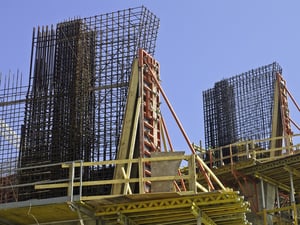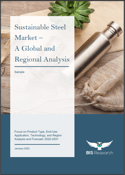 The steel industry has a critical role to play in creating a more sustainable and circular economy. Steel is an essential material in many industries and has a wide range of applications.
The steel industry has a critical role to play in creating a more sustainable and circular economy. Steel is an essential material in many industries and has a wide range of applications.
Essentially, steel is a sustainable material, and its properties remain unchanged no matter how many times it is recycled. However, traditional methods of steel production are often energy-intensive and contribute significantly to greenhouse gas emissions.
More sustainable steel can be produced through steel recycling and the use of renewable energy sources, which reduces the energy and raw material requirements, along with having a lower degradational impact on the environment.
Additionally, factors such as stringent government regulations, carbon neutrality targets, energy and cost efficiency owing to the use of recycled steel, and a significant increase in the demand for steel, along with the scarcity of raw materials and energy, are driving the demand for sustainable steel in the market.
According to BIS Research analysis, the global sustainable steel market is projected to reach $795.8 billion by 2031 from $327.3 billion in 2021, growing at a CAGR of 8.97% during the forecast period 2022-2031.
Thus, the rise of the circular economy presents an opportunity for the steel industry to shift toward more sustainable and efficient production methods. In this blog post, we will explore how the circular economy model is driving the production and adoption of sustainable steel.
What Is the Circular Economy Model?
In the circular economy, waste is viewed as a resource that can be transformed into new products, reducing the need for virgin raw materials. This model promotes the use of renewable energy sources, such as wind and solar power, and encourages the recycling and reuse of materials, such as steel, to conserve resources and reduce emissions.
The circular economy also emphasizes the importance of designing products with longevity, repairability, and recyclability in mind. This approach not only reduces waste but also encourages the use of sustainable materials and production processes.
In contrast to the traditional linear model of take-make-waste, the circular economy model aims to create a self-sustaining system where resources are kept in use for as long as possible, reducing the impact on the environment and promoting economic growth. The circular economy presents a new way of thinking about economic growth, one that prioritizes sustainability and resource efficiency.
In the context of the steel industry, the circular economy means that waste materials and by-products generated during the production process can be reused or recycled.
How Can a Circular Economy Enable Sustainable Steel Production?
Traditionally, waste generated during steel production has been viewed as a burden and often ends up in landfills. However, the circular economy offers an opportunity to turn this waste into valuable resources. Steel production produces a range of by-products, including slag, dust, and fumes, which can be used as raw materials for other industries. For instance, slag can be used in construction as a substitute for aggregate in concrete or as a fertilizer in agriculture. Dust and fumes can also be recycled and reused in the production process, reducing the need for virgin raw materials.
The following are a few examples of how the circular economy has influenced the future of sustainable steel production:
- Adoption of Renewable Energy for Sustainable Steel Production: Adopting renewable energy for sustainable steel production can promote a circular economy by reducing the carbon footprint of steel production and increasing the use of recycled steel. This can be achieved by utilizing renewable energy sources, such as solar or wind power, to power the steel production process, reducing greenhouse gas emissions and the reliance on non-renewable energy sources. Additionally, using recycled steel as a feedstock can reduce the amount of virgin raw materials needed, further reducing the environmental impact of steel production. This approach promotes circularity by reducing waste and extending the life of materials, which is a key principle of a circular economy.
- Decarbonization of Steel Production Procedure: Decarbonizing the steel industry is essential for creating a more sustainable future. The steel industry is responsible for a significant portion of global greenhouse gas emissions, and reducing these emissions is critical for combating climate change. The circular economy provides an opportunity to reduce emissions through the use of renewable energy sources, increased recycling and reuse of materials, and the implementation of more efficient production processes.
- Increasing Investment in Research and Development: Investment in research and development is critical for the continued growth of the circular economy in the steel industry. The development of new technologies and materials that promote sustainability and efficiency is essential for ensuring the long-term viability of the industry. Governments, steel companies, and research institutions must collaborate to invest in R&D, fostering innovation and progress in the steel industry.
Conclusion
The circular economy provides an opportunity for the steel industry to shift toward more sustainable and efficient production methods. From the adoption of renewable energy to the increased recycling and reuse of materials, the circular economy offers a more sustainable future for the steel industry.
It is critical for governments, steel companies, and research institutions to collaborate and invest in R&D to continue promoting sustainability and efficiency in the steel industry. The future of steel production is in the circular economy, and the industry must embrace this new model to create a more sustainable and prosperous future.
Learn More
 For more information on this fast-growing market, please see Sustainable Steel Market - A Global and Regional Analysis, a detailed report packed with data and insights covering market segmentation, recent market developments, market demand, drivers and challenges, the competitive landscape, and key players. This report draws on extensive primary and secondary research to help industry players design the right business strategies for this competitive, ever-shifting market.
For more information on this fast-growing market, please see Sustainable Steel Market - A Global and Regional Analysis, a detailed report packed with data and insights covering market segmentation, recent market developments, market demand, drivers and challenges, the competitive landscape, and key players. This report draws on extensive primary and secondary research to help industry players design the right business strategies for this competitive, ever-shifting market.
About the Publisher: BIS Research is a global market intelligence, research and advisory company that focuses on emerging technology trends that are likely to disrupt the market. Its team includes industry veterans, experts, and analysts with diverse backgrounds in consulting, investment banking, government, and academia.

